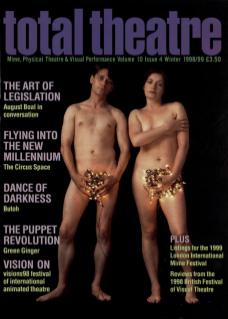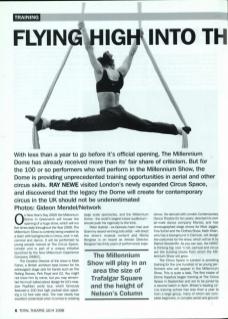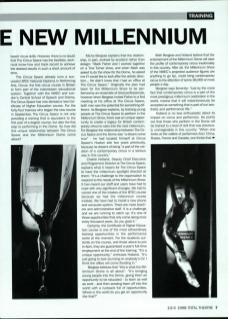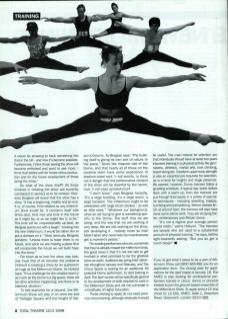On New Year's Day 2000 the Millennium Dome in Greenwich will house the opening of a huge show, which will run five times daily throughout the Year 2000. The Millennium Show is currently being created by a team with backgrounds in circus, rock ‘n’ roll carnival and dance. It will be performed by young people trained at The Circus Space, London and is part of a unique initiative launched by the New Millennium Experience Company (NMEC).
The Creative Director of the show is Mark Fisher, a British architect best known for his extravagant stage sets for bands such as The Rolling Stones, Pink Floyd and U2. You might not know him by name, but you may remember his much talked about design for U2's massive PopMart world tour, which famously featured a 100 foot high cocktail stick spearing a twelve foot wide olive. The man clearly has excellent credentials when it comes to creating large scale spectacles, and the Millennium Dome – the world's largest indoor auditorium – should push his ingenuity to the limit.
Peter Gabriel – ex-Genesis main man and Grammy award-winning solo artist – will direct the show's musical content and Micha Bergese is on board as Artistic Director. Bergese has thirty years of performance experience. He danced with London Contemporary Dance Theatre for ten years; directed his own all-male dance company, Mantis; and has choreographed stage shows for Mick Jagger, Tina Turner and the Clothes Show. Keith Khan, who has a background in Camival, will design the costumes for the show, which will be lit by Patrick Woodroffe. As you can see, the NMEC is thinking big – rock ‘n’ roll, carnival and circus are the building blocks from which the Millennium Show will grow.
The Circus Space in London is providing training for the one hundred or so young performers who will appear in the Millennium Show. This is quite a task. The first intake of Dome hopefuls began training at The Circus Space in September and are to be joined by a second batch in April. Britain's leading circus training school has less than a year to train a large group, many of whom are complete beginners, in complex aerial and ground-based circus skills. However, there is no doubt that The Circus Space has the facilities, technical know-how and track record to achieve the desired results in such a short amount of time.
The Circus Space already runs a successful BTEC National Diploma in Performing Arts, Circus – the first circus course in Britain to form part of the mainstream educational system. Together with the NMEC and London's Central School of Speech and Drama, The Circus Space has now devised a new Certificate of Higher Education course. For the 44 trainees who began the new course in September, The Circus Space is not only providing a training that is equivalent to the first year of a degree course, but also the first step to performing in the Dome. So how did this unique relationship between The Circus Space and the Millennium Dome come about?
Micha Bergese explains that the relationship, in part, evolved by accident rather than design: ‘Mark Fisher and I worked together on a Tina Turner show, and when Mark was asked to do the show for the Dome, he asked me if I would like to look after the artistic direction... He didn't know that I had an office at The Circus Space.’ Originally the plan had been for the Millennium Show to be performed by an ensemble of hired professionals, however when Bergese invited Fisher to a first meeting at his office at The Circus Space, both men saw the potential for something different. As Bergese explains, by training young people at The Circus Space to perform in the Millennium Show, there was a unique opportunity to create a legacy for British contemporary circus to carry into the next millennium. For Bergese the relationship between The Circus Space and the Dome was ‘a dream come true’ – he had located himself at Circus Space's Hoxton site two years previously, because he dreamt of being ‘a part of the creation of a contemporary circus in a serious way in this country’.
Charlie Holland, Deputy Chief Executive and Programme Director at The Circus Space, explains what it means for The Circus Space to have the millennium spotlight directed at them: ‘It's a challenge to the organisation to respond to the needs of the Millennium Show. It has meant our staff and users have had to cope with very significant changes. We had to cancel one of the intakes of the BTEC course because we had the millennium course instead. We have had to install a new phone and computer system. There are more teachers and administrative staff. It is a challenge and we are running to catch up. It's one of those opportunities that only come along once every thousand years. So you grab it.’
The Millennium Show will play in an area the size of Trafalgar Square and the height of Nelson's Column.
Certainly, the Certificate of Higher Education course is one of the most extraordinary training opportunities in the performance world at the moment. For the students currently on the course, and those about to join in April, they are guaranteed a year's full-time employment at the end of the training. ‘It's a unique opportunity,’ enthuses Holland. ‘It's just going to look stunning on anybody's CV. I think the offers will come flooding in.’
Bergese believes that this is what the Millennium Dome is all about. ‘It's bringing young people into the Dome, giving them an opportunity to be educated – to learn as well as work and then sending them off into the world with a rucksack full of opportunities. Where in the world do you get an opportunity like that?’
Both Bergese and Holland believe that the endorsement of the Millennium Dome will raise the profile of contemporary circus inestimably in this country. After all, the Millennium Show (if the NMEC's projected audience figures are anything to go by), could bring contemporary circus to the attention of some 36,000 or more people a day.
Bergese says fervently: ‘Just by the mere fact that contemporary circus is a part of the most prestigious millennium celebration in the world, means that it will instantaneously be accepted as something that is part of our aesthetic and performance life.’
Holland is no less enthusiastic about its impact on circus and performers. He points out that those who perform in the Dome will be trained to a level of skill that was previously unimaginable in this country: ‘When one looks at the calibre of performers from China, Russia, France and Canada, one thinks that it would be amazing to have something like that in the UK – and now it's become possible. Furthermore, I think those seeing the show will become enthused and want to see more. I think that bodes well for future circus productions and for the future employment of those doing the show.’
So what of the show itself? All those involved in creating the show are currently contracted to secrecy as to its content. However, Bergese will reveal that the show has a story: ‘It has a beginning, middle and an end. It is, of course, time-related as any millennium show would be. It concerns itself with times past, time now and time in the future as it might be, or as we might like it, to be.’ The tone will be unquestionably up-beat, as Bergese points out with a laugh: ‘Looking into the new millennium, it would be rather dim to put a damper on it.’ More seriously, Bergese ponders: ‘Unless there is hope there is no future, and since we are making a piece that will incorporate the future we will build hope into the show.’
For clues as to how the show may look, one must first of all consider the problems inherent in creating a show for an auditorium as huge as the Millennium Dome. As Holland says: ‘It's a challenge for the creative team in as much as the Dome is a big space; there will be other activities happening; and there is no blackout situation.’
To talk statistics for a second, the Millennium Show will play in an area the size of Trafalgar Square and the height of Nelson's Column. As Bergese says: ‘The building itself is giving its own sort of nature to the piece.’ Given the massive size of the Dome, and that nearly all of those on the creative team have some experience of stadium-sized rock ‘n’ roll events, is there not a danger that the performance content of the show will be dwarfed by the lavish, rock ‘n’ roll-style pyrotechnics?
‘I don't know,’ says Bergese honestly. ‘It's a large building, it's a large event, a large occasion. The millennium ought to be celebrated with large brush strokes – as well as little ones. Whatever our background, what we are trying to give is something specific to the Dome. The stuff that we are doing, and the way that we are working is very deep. We are still working on the show, still developing it – nobody more so than Mark Fisher who never lets his inventiveness get a moment's peace.’
For budding performers who are concerned that they've already missed the millennium boat, the good news it that it's not too late to get involved in what promises to be the greatest show on earth. Auditions are being held nationally throughout January and February, and The Circus Space is looking for an additional 46 potential Dome performers, to start training in April. The April course will be specifically geared to the development of skills required to work in the Millennium Show and will not culminate in a Certificate of Higher Education.
Those wishing to apply do not need previous circus training, although obviously it would be useful. The main criteria for selection are that individuals should have at least two years intensive training in a physical activity like gymnastics, athletics, martial arts, rock climbing, board diving, etc. Excellent upper body strength is also an essential prerequisite for selection, as is a head for heights and stage presence. Be warned, however, Dome trainees follow a gruelling schedule. A typical day starts before 9am with a warm-up, then the trainees are put through their paces in a variety of specialist techniques – including abseiling, trapeze, tumbling and trampolining. Before classes finish at around 5pm, the trainees will also have done some dance work. They are studying ballet, contemporary and African dance.
‘It's not a regime your average person would relish,’ warns Holland. ‘The trainees are people who are used to a substantial amount of physical training,’ he says, before light-heartedly adding: ‘But you do get a lunch break!’



